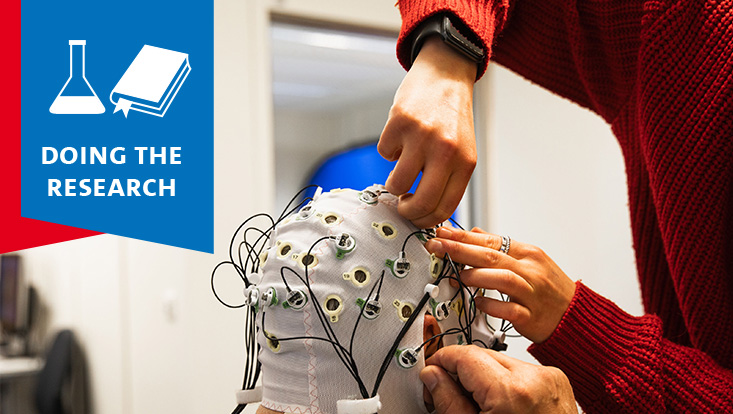Research on obsessive-compulsive disordersHow our brain responds to mistakes and why that can make us sickDoing the Research series
28 April 2025, by Anna Priebe

Photo: University of Hamburg / Göttling
To err is human, yet some people’s brains respond to mistakes with great alarm. Prof. Dr. Anja Riesel, professor of clinical psychology and psychotherapy with a focus on clinical neuroscience at the University of Hamburg, is looking at the role this plays in connection with obsessive-compulsive disorders.
You focus primarily on obsessive-compulsive disorders. What exactly are those?
Obsessive-compulsive disorders are disorders that affect about 2 to 3 percent of the population during their lifetime. They are characterized by intrusive thoughts. What many people might know are things like: Did I turn off the oven? Are my hands really clean? Or, before you travel: Did I pack my passport?
These thoughts are felt as intrusive, lead to restlessness and tension, and result in behavior to ward off the unpleasant feeling or perceived danger. So travelers check 2 or 3 times to see if the passports they packed are really there. People with obsessive-compulsive disorders don’t just do this 2 or 3 times, however; they sometimes keep checking for hours on end or avoid things altogether for fear of not being able to control something. For example, they reject promotions because they need to make sure doors are locked after office hours, which can be a huge burden if you have a compulsive disorder. So their symptoms adversely affect their lives.

You are primarily interested in the impact of sensitivity to errors on obsessive-compulsive disorders. What does this mean?
People make mistakes all the time, of course, and everywhere, but they respond differently to these mistakes. Some people are very relaxed and others react strongly to even small mistakes. Since the late 1980s, there has been a notion that obsessive-compulsive disorders might be connected to an overactive error system in the brain, meaning that patients always have the feeling they have done something wrong and this feeling of doubt strengthens repetitive behaviors and controls. This is the assumption on which we are basing our research.
How can you find out then how strong someone’s perception of mistakes is?
We can analyze a sensitivity to mistakes using a questionnaire. Test subjects have to assess examples with regard to how terrible it is to make a mistake and how they would respond to one. We are much more interested in how people respond to mistakes at a neural level, meaning what happens in their brains. We look at how the reactions between healthy test subjects and patients with obsessive-compulsive disorders differ and whether they can be changed.
We have test subjects solve simple tasks on a computer, for example, and they should say whether the middle arrow of 5 arrows is pointing right or left. This is very simple, but because the other arrows are pointing in the other direction, people can quickly make mistakes. At the same time, we use an electroencephalography, or EEG for short, and look at how the brain responds to these mistakes.
The crucial signals are generated in the anterior cingulate cortex. This region in the cerebral cortex doesn’t respond just to mistakes but also to pain and negative feelings, so whenever something doesn’t work optimally. Following a mistake, we can measure electrical changes on the skull’s surface, or the so-called “error-related negativity” or “theta waves.” They send a message to other brain regions: hey, we need resources to prevent damage!
And do you see significant differences?
You cannot consciously influence these reactions; they happen automatically. And we see that the alarm signal in people with obsessive-compulsive disorders is louder, meaning, they have a stronger neural reaction to mistakes.
In our trials we always compare groups, meaning, on average, error-sensitivity in one group of people with a compulsive disorder is greater when compared to a group of healthy test subjects. At the same time, there are also groups with other clinical pictures, where error-sensitivity is quite low, for example, in addiction disorders. The people within the individual groups, however, may very well differ with regard to sensitivity.
Greater error-sensitivity makes you more susceptible to obsessive-compulsive disorders.
Do you see the strong reaction to mistakes as a symptom or cause for a disorder?
I think it isn’t really a symptom because we have data about the course of treatment, meaning measurements before and after treatment. They show that greater error-sensitivity remains even when compulsive symptoms decrease. We also have done studies with first-degree relatives of patients, meaning parents, siblings, and children. These groups are also at greater risk for an obsessive-compulsive disorder and also showed stronger neural mistake reactions, but no symptoms.
So we conclude that greater error-sensitivity contributes to greater susceptibility to obsessive-compulsive disorders, in interplay with genetic predisposition, how you are raised, and various environmental factors such as stress or extenuating life circumstances. These can make it easier to develop an obsessive-compulsive disorder.
Can we influence sensitivity?
It is about 50 percent genetically determined, but it also depends on how we are raised and our experiences. Studies have shown that the children of punishment-prone parents have a higher risk. It is basically an individual characteristic that is stable but, with practice and experience, changeable.
What does this mean in practice?
If you are at risk, it would naturally be very exciting to consider a preventive implant. We could teach people how important it is to treat mistakes with greater compassion. Initial studies have shown that changing our attitudes to our own mistakes can also influence error-sensitivity. This means it decreases and perhaps with this decrease, our susceptibility to compulsive behaviors also does.
Additionally, prevention could be a way to prevent recidivism. In cognitive behavioral therapy, exposure and response prevention is the method of choice, meaning facing the feared situation, thoughts, and feelings, enduring them, and thus breaking the vicious circle. This is extremely effective. We want to see if targeted concomitant interventions can help at the same time to decrease error-sensitivity and in this way support therapy. I would never use that instead of exposure but it can be an additional option. This is what we are currently trying in our outpatient clinic.
How do you work in outpatient research?
We specialize in anxiety and obsessive-compulsive disorders. However, we are not purely a care provider; we are here solely to support research and teaching. This means that we treat only those patients taking part in a study or who are willing to attend a seminar to talk about their experiences.
Patients taking part in research receive a comprehensive diagnostic preliminary examination where we take the EEG. But they get standard behavioral therapy paid for by the insurance provider. And then they take part in the study again at the end and we look to see what has changed through therapy. So participants are supporting our research and helping us to better understand these disorders.
Outpatient research
The University of Hamburg’s psychotherapy outpatient services have 2 outpatient research clinics. One specializes in psychosis, and Prof. Dr. Anja Riesel heads the one for anxiety and obsessive-compulsive disorders. Services for patients cover outpatient therapy for individuals and group therapy with a focus on cognitive behavioral therapy. There are also regular office hours for relatives and information sessions for patients and relatives.
Doing the Research
There are approximately 6,200 academics conducting research at 8 faculties at the University of Hamburg. Many students also often apply their newly acquired knowledge to research practice while still completing their studies. The Doing the Research series outlines the broad and diverse range of the research landscape, and provides a more detailed introduction of individual projects. Feel free to send any questions and suggestions to the Newsroom editorial office(newsroom"AT"uni-hamburg.de).


